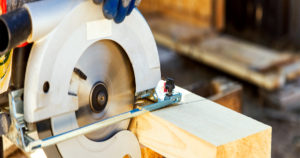The Dangers of Table and Circular Saws
October 29, 2020 Workers in many different industries use table saws and circular saws. Table saws are stationary, whereas circular saws can be handheld or stationary. Though they have several industrial uses, these saws carry some major injury risks. Misuse, lack of safety guarding, and the poor design or defect of table and circular saws result in tens of thousands of amputations, serious nerve and vascular damage, and tendon injuries every year.
Workers in many different industries use table saws and circular saws. Table saws are stationary, whereas circular saws can be handheld or stationary. Though they have several industrial uses, these saws carry some major injury risks. Misuse, lack of safety guarding, and the poor design or defect of table and circular saws result in tens of thousands of amputations, serious nerve and vascular damage, and tendon injuries every year.
While occupational injuries are most common, amateur and at-home woodworkers are also susceptible to sustaining bodily trauma. To mitigate known risks, federal law requires manufacturers of industrial saws to install blade guards to prevent dangerous contact from happening, and employers are obligated to provide comprehensive safety trainings to workers. Despite these measures, thousands of preventable and serious table and circle saw-related injuries continue to occur.
According to the Occupational Safety and Health Administration (OSHA), industrial saws create the following hazards:
- Machine kickbacks. Kickbacks occur when the blade catches the material it is cutting (or the “stock”) and kicks back towards the operator
- Slips and misuse. If the operator’s hands slip while cutting stock or they are too close to the blade while it is in operation
- Flying particles. Particles such as splinters, wood chips, and broken saw teeth can be thrown during saw operation
- Machine maintenance. Workers can be injured when they remove cut pieces of stock or scrap materials from the blade of the saw
- Other moving parts. Sometimes when using table saws, injuries happen if the operator comes into contact with the portion of the blade under the table
Workplace Injuries
Approximately 40,000 people go to emergency rooms for saw-related finger, hand, and arm injuries each year, says the National Consumers League (NCL). Nearly 4,000 of those injuries are amputations. Since table saws and circular saws present such considerable hazards to workers, employers must take steps to keep the workplace safe. There are a main ways that employers can effectively limit saw-related injury rates, including:
- Never remove blade guarding. In as many as two-thirds of all injury cases, the blade guarding on the saw has been taken off. For table saws, guard the portions above and below the table. Also guard the power transmission apparatus, which includes the pulleys, chains, belts, and sprockets
- Provide workers with appropriate personal protective equipment, or PPE. This includes eye and face protection
- Inspect and maintain saws. Remove any cracked or damaged blades from service, make sure blades are sharp, use the right blade for the job, etc.
- Provide proper safety and use training. Teach workers to recognize, report, and avoid hazards, like point of operation dangers that occur when a worker’s hands enter the cut line
- Follow all manufacturing guidelines
Saw Manufacturers: Machine Defects and Design Flaws
There are also effective systems out there that manufacturers can use to prevent serious saw blade injuries from happening. For example, there is a technology that stops a saw blade from moving in less than one second of contact. Other technologies retract the blade in mere milliseconds. Some of these technologies are already available in table and circular saws that are on the market, while others are still being developed. The bottom line is that lawmakers and industrial manufacturers alike need to prioritize table saw safety in order to reduce national injury costs and preventable workplace disability.
As mentioned earlier, manufacturers must install blade guards on saws. Nevertheless, one-third of all table saw injuries happen with the guarding in place, meaning it is not doing a sufficient job at protecting operators from injury. Other injuries result from improper product design or dangerous defects. If a defective or unreasonably unsafe table or circular saw causes injury to a worker, the manufacturer may be liable.
To learn more about filing a claim against a manufacturer or your employer, contact a representative at our firm who can help now.
Philadelphia Personal Injury Lawyers at Galfand Berger, LLP Representing Injured Workers Since 1947
With offices located in Philadelphia, Bethlehem, Lancaster, and Reading, Galfand Berger serves clients throughout Pennsylvania and New Jersey. To schedule a consultation, call us at 800-222-8792 or complete our online contact form.
 Google Screened
Google Screened
